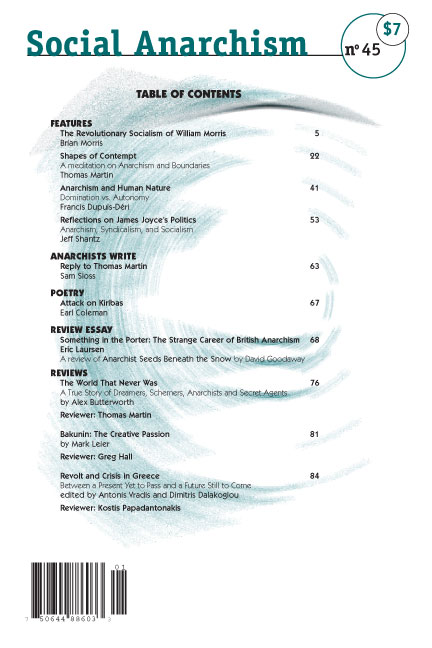Shapes of Contempt
a meditation on anarchism and boundaries
Page: 2
the territorial ‘instinct’
Territoriality,[i] as usually defined by ethologists, appears to be a characteristic of many animal species, though by no means all. It has little or nothing to do with taxon – some insects are territorial, some not; the same for birds, mammals, reptiles, and so on. The same is true for primates. Probably it has evolved as a response to the availability of food. Insect-eating birds are usually not territorial, since insects are almost everywhere, and not evenly distributed, stationary or concentrated in certain places. Raptors usually are territorial, since they must defend a relatively large area in which food (such as rodents) is harder to find, and scarce enough that other raptors can be competition. Territories are usually but not always defended against members of one’s own species. They can be ‘marked’ in all sorts of ways, most commonly among mammals by the deposit of scent, among birds by aggressive displays or threats that rarely become actual violence.
For human beings, and probably for a few other species, the most fundamental boundary is the ego, the sense of “I.” All cultures have engendered philosophies that seek to eliminate the ego, or at least to demonstrate its ultimate unreality. It’s an interesting question, though beyond our scope here, as to why these philosophies have had far more success in Asia (Zen Buddhism, for example) than in the West (medieval Christian mysticism) or why the idea is more or less irrelevant in still other cultures (sub-Saharan Africa, for instance). Probably it has a lot to do with language, which in the West tends to chop reality up into small discrete bits and isolate them into categories. Among modern radical ideologies, deep ecology has most concerned itself with this question, suggesting that we cannot hope to save the planet unless we literally identify ourselves with it.
Still, it is difficult to define any living organism without assigning some sort of boundary to it, however arbitrary. A layer of dead cells, if we are talking about anything larger than microscopic size; or at least, in Tyler Volk’s words, “"Life at the smallest scales boasts a cornucopia of protective edges."[ii]
Moving out just beyond the boundaries of the ego, we next encounter what is usually called “personal space,” the zone surrounding our bodies into which other people should not intrude. Personal space has been the subject of many sociological and psychological studies in recent decades, and we probably understand it fairly well now. We are concerned here only with the human species, but it must be recognized that territoriality is a product of evolution, and so is hard-wired to a limited extent. Its size and whether it is switched on or off depends on the environment. It is hard-wired (perhaps in the amygdala) only in the sense that everyone has it; but its ‘size’ and more important, the way we view it, varies immensely from one culture to another and somewhat less so among individuals in the same culture. It is well documented that Americans, for instance, require more personal space than Europeans, who require more than Asians, and so on – the difference has to do with the average density of population in the homes and towns of those regions. It also changes over time, as documented by Ariès and Duby in their multivolume History of Private Life.[iii] And of course it varies depending on who the other individual is – we will switch it off altogether for the right sexual partner, but expand its boundaries for someone we do not like. Everyone develops subconscious strategies for dealing with situations in which our space is invaded, but we can’t do anything about it, as on a crowded subway – avoiding eye contact, for example.
The expansion of personal space into personal real estate probably dates back to our pre-human ancestors, who hunted in packs that evolved over time into bands and tribes. Humans lived quite comfortably, in small numbers, for hundreds of millennia, as foragers and hunters. The mythology of nearly every culture looks back with nostalgia on that tranquil Eden.[iv] As chimpanzees still do, the tribe had a shared mental picture of a vague territory in which they gathered and hunted, and which now and then had to be defended against other groups of humans. But the territory moved with the group, and had no boundaries in our sense of the word. As Freya Mathews points out, so-called ‘primitive’ people like Australian aborigines and African San (Bushmen) look at the world as a tangle of lines, carrying them off in various directions towards game, or water, or sacred places. Pastoral and, later, agricultural people saw the world as a circular territory, radiating out from where they happen to live.[v]
Since most studies of human territoriality have come from sociologists and biologists, we have been taught to understand that it is an instinct linked to aggression and shared with other animals, and is socially or environmentally constructed only in a peripheral way. Robert Sack’s Human Territoriality, published in 1986, is a minority opinion, but probably closer to the truth. In humans it is not always expressed as aggression, and it serves purposes that would be meaningless to other creatures. “Territoriality in humans is best understood,” he writes, “as a spatial strategy to affect, influence, or control resources and people, by controlling area; and, as a strategy, territoriality can be turned on and off.”[vi] Sacks is a geographer, and concerned with the ways in which people manage land, physical territory. He demonstrates clearly that a group’s sense of territory can be altered sharply by contact with very different groups (the Chippewa and the Europeans are his prime example), or by stresses within the group, as well as by climate change, economic issues, and even religion – one reason that the bishops of Rome became the all-powerful Popes, he says, was their physical possession of the tomb of St Peter.[vii]
It is impossible to conceive of any human relationship that does not have a spatial component (or indeed, of anything at all that does not have a spatial component). Indeed there is a relatively new field, spatial logic, that seeks to understand how and why a given set of entities relate to one another to form a structure that persists through time. So far, spatial logic is of interest only to theoretical mathematicians and structuralist philosophers, but some applications are envisioned for cybernetics and linguistics. Historians have begun to use the term when looking at such fluctuating entities as trade networks and the effect of increasing or decreasing urban densities on everyday life. Indeed, it has been persuasively argued that history without some form of spatial logic is little more than “heaps of fragments.”[viii]
Footnotes
-
[i] Indo-European *ters, dry, as in ‘dry land.’ The asterisk conventionally used with IE roots indicates that they are hypothetical reconstructions; IE was never a written language.
-
[ii] Tyler Volk, Metapatterns: Across Space, Time, and Mind (New York: Columbia University Press, 1995), 51.
-
[iii] Ariès, Philippe and Georges Duby, eds., A History of Private Life (Cambridge, MA: Belknap Press of Harvard University Press, 1987), 5 vol.
-
[iv] Colin Tudge, The Time before History: 5 Million Years of Human Impact (New York: Scribner, 1996), 264ff.
-
[v] Freya Mathews, "The Soul of Things," Terra Nova, vol. 1, no. 4 (Fall 1996), 59.
-
[vi] Robert Sack, Human Territoriality: Its Theory and History (Cambridge University Press, 1986), 1-2.
-
[viii] Fredric Jameson, Postmodernism, or The cultural logic of late capitalism (Durham: Duke University Press, 1991), 25.

